Philippine pork dishes showcase the country's culinary diversity and love for savory flavors. Lechon, a popular dish often served during celebrations, features a whole roasted pig with crispy skin and tender meat. Adobo, considered the national dish, consists of pork marinated in soy sauce, vinegar, garlic, and spices, then braised until tender. Sisig, a sizzling pork dish, is made from chopped pork face and ears seasoned with calamansi, onions, and chili peppers. These dishes highlight the Philippines' creative use of pork, offering a tantalizing blend of savory, tangy, and spicy flavors deeply rooted in Filipino culinary tradition.
Sisig

Sisig is a popular Filipino pork dish that is known for its bold and flavorful taste. It is typically made from parts of the pig's head, such as the cheeks and ears, which are boiled and grilled before being finely chopped. The meat is then sautéed with onions, garlic, and chili peppers, giving it a spicy kick. What sets sisig apart from other pork dishes is its unique cooking technique. After being cooked, the meat is traditionally served on a sizzling hot plate, creating a sizzling sound and releasing aromatic smoke. This presentation adds an element of excitement and anticipation to the dining experience. Sisig is often enjoyed as a pulutan, or a dish paired with alcoholic beverages, making it a popular choice for social gatherings and nights out with friends. It is typically served with a side of calamansi, a local citrus fruit, which adds a tangy and refreshing flavor to the dish.
Batchoy
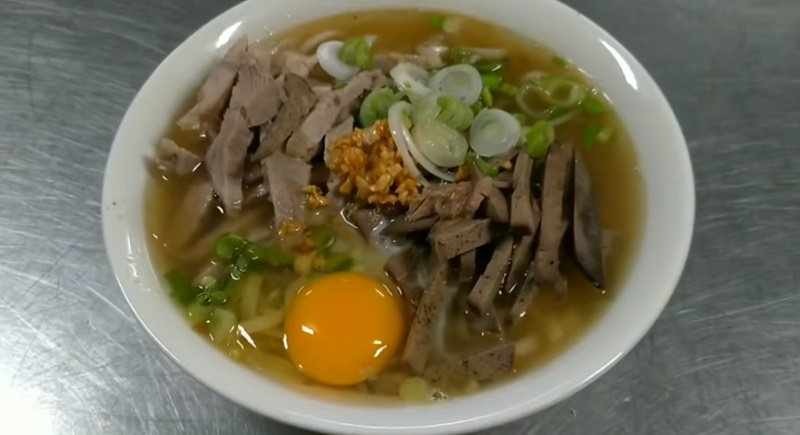
Batchoy is a popular pork dish that originated in the Philippines, specifically in the region of Iloilo. It is a hearty and flavorful soup that is loved by many Filipinos. The dish is made with a rich and savory broth, typically made from pork bones and various spices. The soup is then filled with a variety of ingredients, including pork meat and organs such as liver, kidneys, and intestines. These ingredients are cooked until tender, adding depth and texture to the dish. Batchoy is typically served with egg noodles, giving it a satisfying and filling quality. Additional toppings may include crispy pork cracklings, green onions, and garlic. The combination of these ingredients creates a harmonious blend of flavors that is both comforting and delicious.
Bagnet
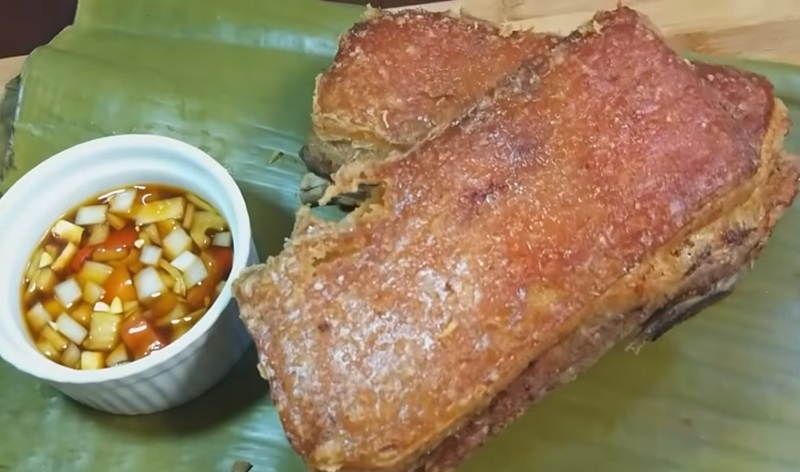
Bagnet is a popular pork dish in the Philippines that originated from the Ilocos region. It is made by boiling pork belly until tender, then deep-frying it until the skin becomes crispy and the meat turns golden brown. The result is a mouthwatering dish with a perfect combination of tender and succulent meat with a crunchy and flavorful skin. Bagnet is often served as a main dish, accompanied by a dipping sauce made from vinegar, soy sauce, and spices. It is commonly enjoyed with steamed rice and vegetables, creating a satisfying and hearty meal. The dish is known for its rich and savory taste, with the crispy skin providing a delightful contrast in texture.
Lechon Kawali

Lechon Kawali is a popular and mouthwatering pork dish in the Philippines. It is made by deep-frying a whole slab of pork belly until the skin becomes crispy and the meat turns tender and juicy. The name "lechon kawali" is derived from the Filipino words "lechon" which means roasted pig, and "kawali" which means frying pan. The preparation of lechon kawali involves boiling the pork belly in water and aromatics until it becomes tender. It is then cooled and air-dried to remove excess moisture. The pork is finally deep-fried in a sizzling hot oil until the skin turns golden brown and crispy. Lechon kawali is typically served with a tangy and savory dipping sauce made from vinegar, soy sauce, garlic, and chili. The combination of the crispy skin and tender meat creates a delightful contrast in texture and flavor.
Humba
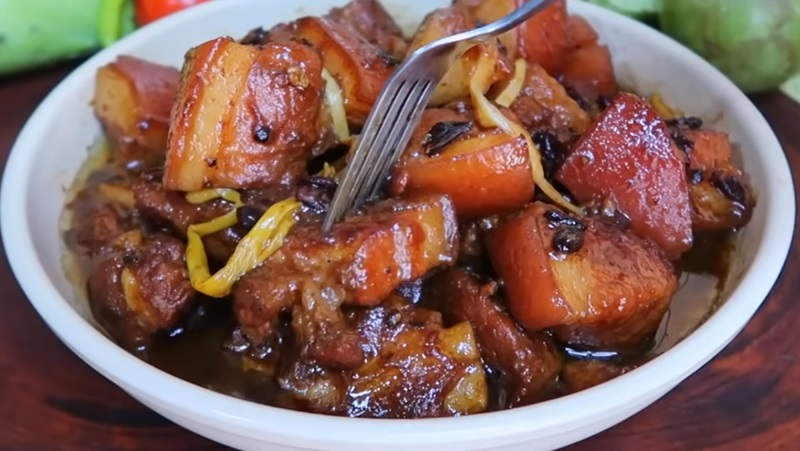
Humba is a popular pork dish in the Philippines that is known for its rich and flavorful taste. It is a dish that originated from the Chinese and was adapted to fit the Filipino palate. Humba is made by simmering pork belly or pork hocks in a mixture of soy sauce, vinegar, brown sugar, garlic, and spices. The dish is characterized by its sweet and salty flavor, as well as its tender and juicy meat. The long cooking process allows the flavors to meld together, resulting in a dish that is both hearty and satisfying. What sets humba apart from other pork dishes is the addition of fermented black beans and banana blossoms, which give the dish a unique and distinct taste. The beans add a savory element to the dish, while the banana blossoms provide a subtle sweetness. Humba is truly a Filipino comfort food that showcases the country's love for pork and its rich culinary history.
Nilaga
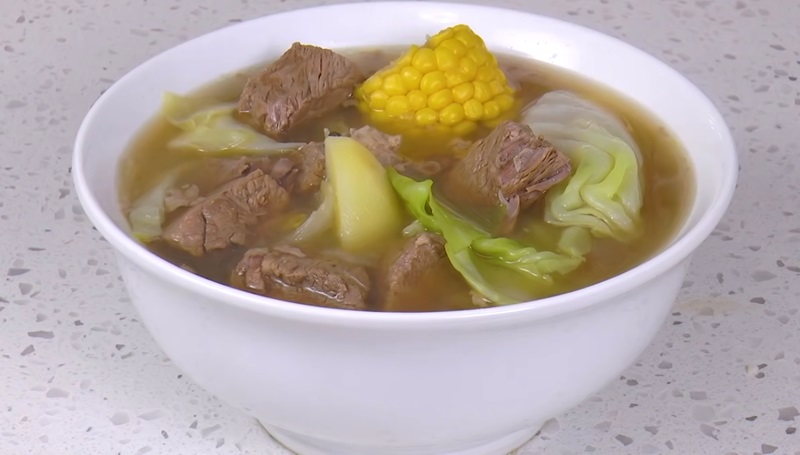
Nilaga is a popular Filipino pork dish that is known for its simplicity and delicious flavors. It is a comforting and hearty soup made with tender pork chunks, vegetables, and a flavorful broth. The word "nilaga" translates to "boiled" in English, which perfectly describes the cooking process of this dish. To make nilaga, pork pieces, such as pork belly or shoulder, are simmered in water along with onions, garlic, and peppercorns until the meat becomes tender and flavorful. The soup is then enriched with vegetables like cabbage, potatoes, carrots, and green beans, adding color and texture to the dish. Some variations may also include corn or bok choy. The flavors of the pork and vegetables meld together in the rich broth, creating a savory and satisfying meal.
Hamonado
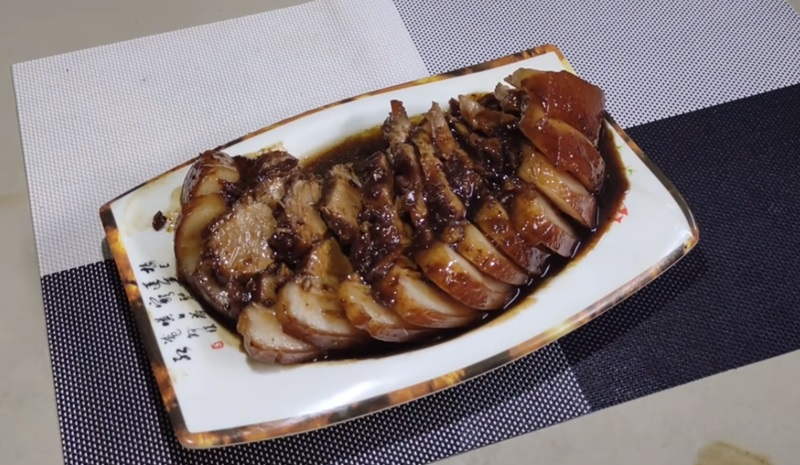
Hamonado is a popular Filipino pork dish that is known for its sweet and savory flavors. It is made by marinating pork slices in a mixture of soy sauce, pineapple juice, brown sugar, and various spices. The marinated pork is then simmered until tender and the sauce thickens to a rich glaze. The combination of soy sauce and pineapple juice gives the dish a unique tangy taste that balances well with the sweetness from the brown sugar. The spices used in the marinade, such as garlic and pepper, add depth and enhance the overall flavor profile.
Pata Tim

Pata Tim is a popular Filipino pork dish known for its tender and flavorful braised pork hock. This dish is commonly served during special occasions and gatherings, making it a staple in Filipino cuisine. To prepare Pata Tim, the pork hock is first marinated in a mixture of soy sauce, oyster sauce, sugar, and spices for several hours to enhance its taste. Once marinated, it is then braised slowly in a savory broth until the meat becomes tender and succulent. The resulting dish is a delightful combination of sweet and savory flavors, with the pork hock absorbing the rich sauce it was cooked in. The gelatinous texture of the pork skin adds a unique and satisfying mouthfeel to the dish. Pata Tim is often garnished with green onions and served alongside steamed rice, making it a hearty and filling meal.
Kadyos, Baboy, Kag Langka
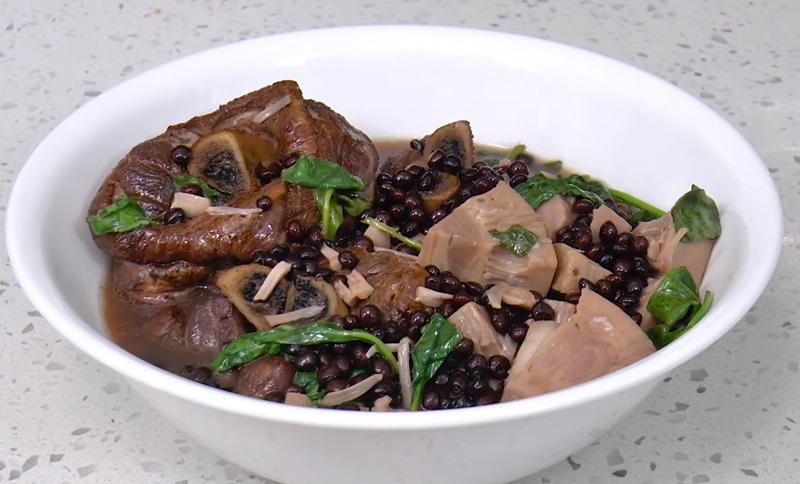
Kadyos, baboy, kag langka is a traditional Filipino dish that combines three key ingredients: kadyos (pigeon peas), baboy (pork), and langka (jackfruit). This flavorful dish is a popular specialty from the Western Visayas region of the Philippines. To prepare this dish, the kadyos and langka are first boiled until tender. In a separate pan, the pork is sautéed with garlic and onions until browned. The boiled kadyos and langka are then added to the pan, along with water or broth, and simmered until the flavors meld together. The combination of the earthy pigeon peas, succulent pork, and sweet jackfruit creates a harmonious blend of flavors. The dish is typically seasoned with fish sauce, black pepper, and other spices to enhance the taste.
Tuslob Buwa

Tuslob buwa is a popular Filipino pork dish that originates from Cebu City in the Philippines. It is a unique and flavorful dish that is loved by locals and tourists alike. The dish gets its name from the way it is prepared and enjoyed. Tuslob buwa literally translates to "dipping in bubbles" in the local Cebuano dialect. It is made by simmering pork brains, liver, and other pork offal in a savory soy sauce-based broth. The mixture is then cooked until it thickens to a rich and creamy consistency. To enjoy tuslob buwa, a large wok or pan is filled with the thickened mixture and placed in the center of the table. It is traditionally eaten by dipping puso (steamed rice wrapped in coconut leaves) or puso ng saging (banana blossoms) into the bubbling sauce.
Everlasting (food)
-1703208934.jpg)
Everlasting, also known as "lumpiang hubad," is a popular Filipino pork dish that is a delicious combination of flavors and textures. This unique dish is made by sautéing ground pork with garlic, onions, and various spices until it is cooked through and flavorful. The pork mixture is then wrapped in fresh lettuce leaves, creating a vibrant and refreshing presentation. What sets Everlasting apart is the assortment of toppings and condiments that accompany it. Common additions include steamed rice noodles, diced tomatoes, sliced cucumbers, fried tofu, and crushed peanuts. The dish is often drizzled with a tangy and savory sauce made from vinegar, soy sauce, and calamansi juice.
Philippine Asado
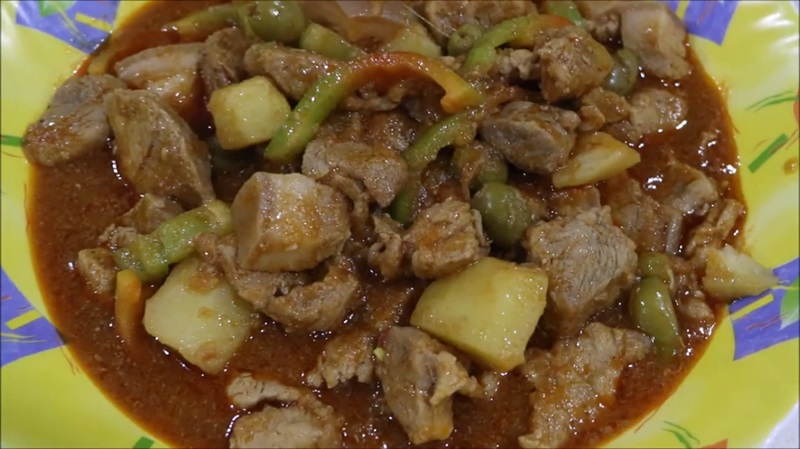
Philippine asado is a delicious pork dish that is popular in the Philippines. It is a sweet and savory dish that features tender pork cooked in a flavorful sauce. The dish is known for its unique combination of flavors, blending the sweetness of sugar and the tanginess of soy sauce. To make Philippine asado, pork is marinated in a mixture of soy sauce, sugar, garlic, and spices. The marinated pork is then simmered in the marinade until it becomes tender and flavorful. The result is a melt-in-your-mouth pork dish that is rich in taste and aroma. The combination of the tender pork with the sweet and savory sauce creates a perfect balance of flavors.
Estofado
-1703209746.jpg)
Estofado is a delicious and hearty pork dish that is popular in the Philippines. It is a Spanish-influenced dish that has been adapted and made uniquely Filipino. The dish is made by stewing tender chunks of pork in a flavorful sauce made from soy sauce, vinegar, and a variety of spices. The sauce is typically sweet and tangy, with hints of garlic, onions, and bay leaves. The pork is cooked until it is tender and flavorful, allowing the flavors of the sauce to penetrate the meat.
Batchoy Tagalog
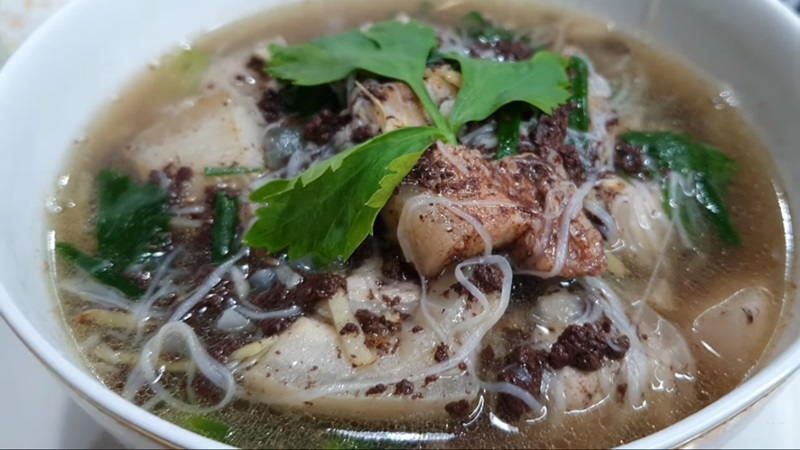
Batchoy Tagalog is a popular pork dish in the Philippines, known for its rich and flavorful broth. This hearty soup is made with tender slices of pork meat and offal, such as liver, kidney, and intestines. The dish is traditionally cooked by simmering the pork with onions, garlic, and various spices, creating a savory and aromatic broth. What sets Batchoy Tagalog apart from other pork dishes is the addition of miki noodles, which are thick egg noodles that absorb the flavors of the broth. These noodles give the dish a satisfying and filling quality. Other ingredients like vegetables, such as cabbage and beansprouts, are also added to provide texture and freshness. Batchoy Tagalog is often garnished with crunchy chicharron (pork cracklings), scallions, and a squeeze of calamansi juice for a tangy kick.
Tokwa't Baboy

Tokwa't Baboy is a popular Filipino pork dish that consists of two main ingredients: tofu (tokwa) and pork (baboy). The dish is a combination of fried tofu cubes and crispy pork belly slices, served with a tangy soy-vinegar dipping sauce. To prepare tokwa't baboy, tofu is first cut into bite-sized cubes and deep-fried until golden and crispy. Meanwhile, pork belly is boiled until tender, then sliced into thin strips and fried until crispy. The tofu and pork are then arranged on a plate and drizzled with the soy-vinegar sauce, which is made by combining soy sauce, vinegar, chopped onions, garlic, and chili peppers. The contrasting textures of the crispy tofu and pork, along with the flavorful dipping sauce, make tokwa't baboy a delightful dish to enjoy.
Pinatisan

Pinatisan is a traditional Filipino pork dish that is rich in flavor and loved by many. This mouth-watering dish is made by marinating pork in a mixture of soy sauce, vinegar, garlic, onions, and patis (fish sauce). The pork is then simmered in the marinade until it becomes tender and absorbs all the flavors. The key ingredient that sets Pinatisan apart from other pork dishes is the patis, which adds a unique umami taste to the dish. The combination of soy sauce and vinegar gives it a perfect balance of sweetness and tanginess. The garlic and onions provide a delightful aroma, enhancing the overall taste. Pinatisan is often served with steamed rice and paired with a side of vegetables or pickled papaya (atchara). The tender pork, soaked in the rich marinade, is incredibly flavorful and satisfying.
Waknatoy

Waknatoy is a traditional pork dish from the Philippines that is known for its rich and flavorful taste. It is a popular dish in the Visayas region, particularly in the provinces of Iloilo and Capiz. Waknatoy is made by simmering pork with a variety of ingredients such as soy sauce, vinegar, onions, garlic, and spices. This combination creates a savory and tangy sauce that coats the tender pieces of pork. The dish is often garnished with green onions and served with steamed rice. What sets Waknatoy apart from other pork dishes is the addition of native vinegar and achuete, a red food coloring derived from annatto seeds. These ingredients give the dish its distinct reddish color and enhance its flavor profile.
Paksiw Na Pata
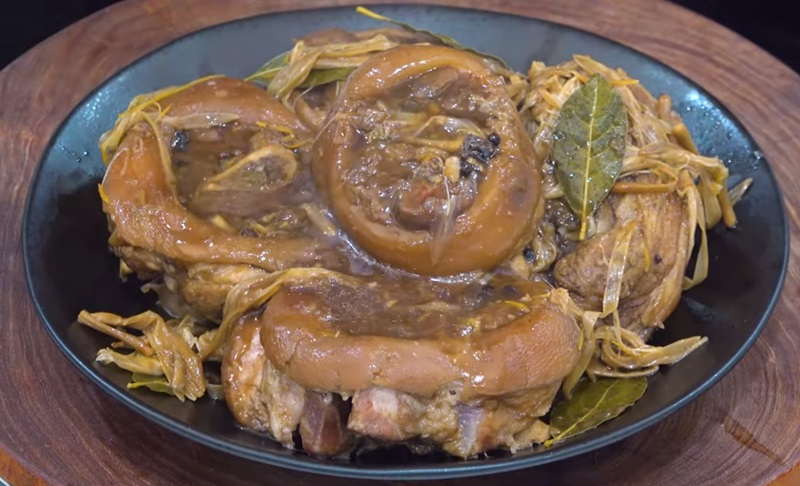
Paksiw na pata is a popular Filipino pork dish that showcases the rich and flavorful cuisine of the Philippines. "Pata" refers to pork hock or knuckles, which are slowly simmered in a tangy and savory vinegar-based broth. To prepare this dish, the pork hocks are first marinated in a mixture of vinegar, soy sauce, garlic, onion, and spices. The marinated pork is then simmered in the same marinade along with bay leaves and peppercorns until tender and succulent. The slow cooking process allows the flavors to meld together, resulting in a deeply satisfying and aromatic dish. The tender pork hocks absorb the tangy and slightly sweet flavors of the vinegar, creating a delightful contrast with the richness of the meat. The dish is often garnished with chopped scallions or fried garlic to add a burst of freshness and crunch.
Binagoongang Baboy
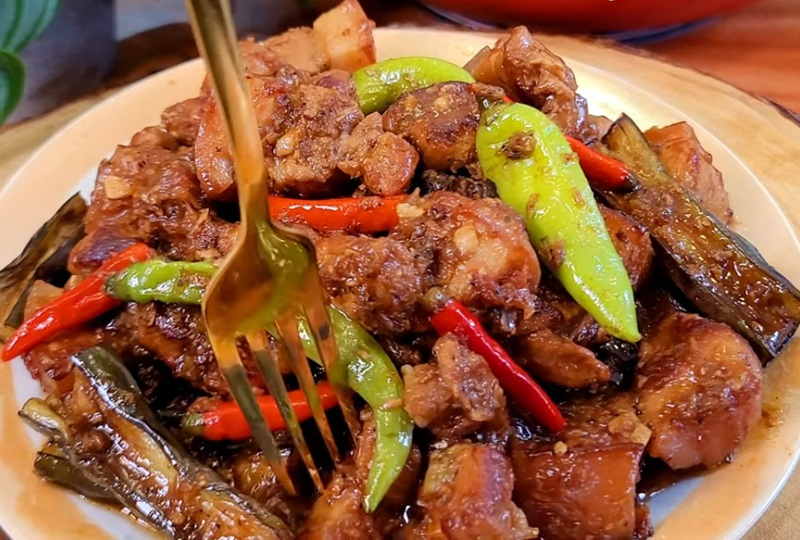
Binagoongang Baboy is a popular Filipino pork dish that combines the rich flavors of pork and shrimp paste. It is a savory and tangy dish that is loved by many Filipinos. To make binagoongang baboy, pork belly or pork shoulder is usually used. The meat is marinated in a mixture of garlic, onions, and vinegar to enhance the flavor. It is then simmered until tender and cooked with shrimp paste, tomatoes, and chili peppers. The shrimp paste, or bagoong, gives the dish its distinctive taste and aroma. It adds a salty and umami flavor to the pork, creating a delightful combination of flavors. The tomatoes provide a hint of sweetness and the chili peppers add a spicy kick.
Afritadang Baboy

Afritadang Baboy is a traditional Filipino pork dish that is known for its rich and savory flavors. It is a popular main course that is often served during special occasions and family gatherings. The dish is made by simmering tender chunks of pork in a flavorful tomato-based sauce. The sauce is typically made with a combination of tomatoes, onions, garlic, and bell peppers, which give the dish its distinct taste and vibrant colors. It is then seasoned with soy sauce, fish sauce, and other spices to enhance the flavors. The pork in afritadang baboy is often cooked until it becomes fork-tender, making it incredibly juicy and tender. The combination of the tender pork and the flavorful sauce creates a delicious and satisfying dish that is best enjoyed with steamed rice. Afritadang baboy is often served with a side of vegetables such as carrots, potatoes, and green peas, adding more texture and nutrients to the dish.
Paksiw Na Lechon

Paksiw Na Lechon is a mouthwatering Filipino pork dish that is made from leftover lechon, a roasted whole pig commonly served during special occasions. This delectable dish is prepared by simmering the lechon leftovers in a flavorful mixture of vinegar, soy sauce, garlic, onions, bay leaves, and peppercorns. The combination of vinegar and soy sauce gives paksiw na lechon its distinct tangy and savory taste. As the lechon simmers in the sauce, it absorbs the flavors, resulting in tender and succulent meat that is infused with the rich aroma of the spices. Paksiw na lechon is often enjoyed with a bowl of steaming rice and a side of sautéed vegetables. The tangy sauce complements the meat perfectly, making each bite a delightful explosion of flavors. What sets paksiw na lechon apart is its ability to transform leftover lechon into a completely different dish that is equally delicious.













-1709813013.jpg)


